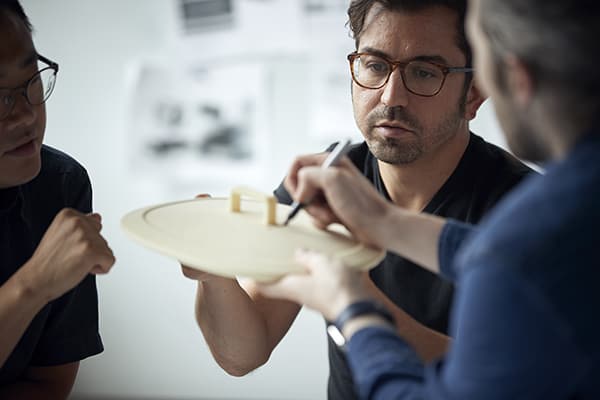Why Design Thinking is Critical for the Prosperity of Your Business.
We are at a turning point in business. After a significant contraction, the economy is starting to bounce back, but as we find our way back to normal, companies will also need to find new ways to set themselves apart. Relying on incumbent revenue streams as the only model for growth just isn’t viable — with changes as pronounced as the ones that our culture is facing, from remote work to online shopping to expanding 5G infrastructure, the entire culture is shifting.
So, volatility is high, but that’s actually a good thing. It means that this is a great time to reshape people’s mindsets and behaviors, develop new solutions, and place bold bets on designing growth. Customer expectations are ever-changing, and companies are all feeling the pain of needing to stay relevant and understand how COVID-19 changed everyone’s operating landscape.
To take advantage of — rather than be at the mercy of — these shifts, companies like yours will need to replace lost revenue sources because of the pandemic with new sources of growth. You may even need to reframe your businesses. While that may sound daunting, adopting a Design Thinking process can help you understand your market, understand your customers, and understand what you need to offer to arrive ahead.
Design Thinking is crucial for businesses looking to not only survive but thrive in 2021 as we begin to exit the COVID-19 pandemic. When executed correctly, the process can help companies identify how they should change and what they should be doing to serve customers better in this changing world.
What is Design Thinking?
Design Thinking is a human-centered process of problem-solving. Rather than developing a new product or service through a tech- or trend-centered lens, Design Thinking focuses intensely on understanding the people you are creating for at the center of the process. Moreover, it’s about understanding people within the context of their everyday lives through a process of empathizing, challenging assumptions, reframing problems, ideating solutions, and prototyping products, and testing their viability.
Why is Design Thinking necessary?
Maintaining original revenue streams makes sense (as long as they’re viable). Still, to sustain growth (especially the organic type that comes from continually meeting changing customer needs), companies need to develop and maintain a continuous pipeline of new business-building initiatives.
Organic growth is difficult for organizations; it’s outside what most organizations are traditionally good at—defending and extending incumbent revenue streams that account for their lion’s share of many companies’ profits and cash flow.
But here’s what your goal should be: a growth pipeline full of new initiatives ready to be launched into the world as existing ones tire and falter. Companies will need to split their focus. Not only paying attention to where they are today but also to where they are heading tomorrow. It’s about organizational multitasking and being able to forecast with foresight — balancing the demands of running your existing business today while building new lines of revenue for the future.
To achieve all this amazing organic growth though, organizations need to overcome a few hurdles. Luckily, Design Thinking can help not only clear those hurdles but thrive in new, unexplored territory, both internally and externally.
Six barriers to organic growth and how design thinking can help:
1. Lack of long-term thinking.
Creating organic growth through business-building requires long-term thinking. It’s inescapable; if you are not prepared to lead with a future-focused perspective, it’s going to be tough. Often, this will even involve a cultural change.
Design Thinking helps you take a broader look at your operating environment, considering those macro forces acting on your industry and category and mapping areas of opportunity for potential growth supported by the key drivers of change. Design thinking helps organizations to reorient for forward thinking growth and begin to lead from the future.
2. Lack of customer understanding.
Nothing innovative happens without disruptive insights. An organization created to solve and sell a solution to a problem that existed 15 years ago may likely find on connecting with their audiences that it’s not so much of a problem anymore.
Design Thinking helps illuminate opportunities amid uncertainty and helps us solve the right problems. Customer knowledge informed by an empathetic mindset is critical for creating relevant new offerings that are both pertinent and differentiated. To this point, Design Thinking is a great way to better understand consumers in a post-COVID 19 world. Its empathy positions you to adopt a proactive posture in approaching what might otherwise feel like a foreboding future.
3. Lack of investment in new customer relationships.
Shifting consumer social values and behaviors are key drivers for creating white space market opportunities.
Design Thinking helps by offering real, valuable customer insight. The whole process is centered on building something just the way a customer would want it, using co-creation to uncover new value for customers rather than relying on standard market research.
4. Low tolerance for risk.
Businesses aren’t just scared of taking the leap toward something new — they’re scared of leaping into something new that’s going to cost them a lot of money.
Design Thinking helps by mitigating risk. It’s focused on small-scale experimentation with nimble teams that start small and enable organizations to learn what can work at scale. It does not have to be the building of a grand innovation center with bean bag filled collaboration spaces; it can be a whiteboard, some post-it notes, and a slab of foam core to start with.
5. Lack of operational freedom.
Extending and defending the profit-generating center of an organization’s core business is (understandably) going to get the lion’s share of attention. It’s just natural, but for mature businesses especially, you have to be careful not to run out of steam.
Design Thinking helps you seed the future, and the process enables you to do it in a tight and focused way with a small team dedicated to both creating new value and a continuous new stream of businesses.
6. Lack of adaptability.
Large corporations are not known for their nimbleness or adaptability as they are typically built around the management paradigm of delivering the same thing again and again with high predictability and the same level of quality today as yesterday. Innovation, however, represents change, and that can be uncomfortable for organizations if they are to discover new opportunities and seed new businesses for the future.
Design Thinking helps to embed a flexible mindset and pushes an organization to start being agile. Failing-fast and using rapid learning cycles to do so places a strong emphasis on experimentation, and rapidly iterating towards a “better” answer.
Why Design Thinking now?
For many businesses, design remains this mysterious activity removed from typical business norms; a creative endeavor that sits outside of traditional business processes and metrics. As a result, historically, it hasn’t been central to an organization’s strategy for success.
This is due in part to design being difficult to define and hard to isolate as a function. In recent years, the Design Management Institute (DMI) created and tracked what has become known as the Design Value Index. The Design Value System has three components: The Design Value Index, The Design Maturity Matrix, and the Design Value Map. In 2015 index results showed that design-led companies who have embraced Design thinking had outperformed the S&P by an extraordinary 211% over the last ten years. McKinsey, in a 2018 report, “The business value of design,” tracked the design practices of 300 publicly listed companies over five years in multiple countries and industries. Companies in the McKinsey Design Index (MDI) increased revenues substantially over their traditional industry counterparts with an average of 32 percentage points revenue growth.
Design Thinking offers a way to move from defense to offense by listening deeply to customers and facilitating their stories through the power of design. A design-led mindset helps you wrap your arms around ambiguity and evaluate the impact of emerging insights as they evolve. Design is change, design creates the new, and good design is empathetic, tapping into the desires, needs, and wants of people in ways that traditional business fall short. Design Thinking is part of a winning approach, a critical component to launching and scaling new businesses and categories.
Getting started with Design Thinking
Design Thinking is a kick-starter to growth, but it can also be managed easily within a program of work separate from your core business activities. To start, employ a consultant or spin out a dedicated group of employees who are comfortable with ambiguity and who have the capability for deep empathy and a talent for rigorous synthesis.
Here are the four major steps in the Design Thinking process:
STEP 1 – DISCOVER: OBSERVE | EXPERIENCE | UNDERSTAND
Step One of the design thinking process is all about seeing the world with fresh eyes, and where empathy becomes perspective. It’s about getting out there in the big wide world and observing, experiencing and understanding the end-user of your product or service in the context of their daily lives. In the “Discover” phase you should be:
– Openly questioning why the world is the way it is
– Moving beyond the obvious by carefully observing what is not said
– Asking open ended questions, looking for needs and insights
– Getting to the WHAT, the HOW and the WHY
– Capturing the learnings visually through photographs and sketches
– Creating process and mind maps to identify critical pain points
STEP 2 – DEFINE: MODEL | QUESTION | REFRAME
Step Two of the design thinking process is about gaining new perspectives that lead to a disruptive insights. It’s all about questioning the status quo, seeing the problem from a fresh perspective, and developing a new and unique point-of-view. In the “Define” phase you should be:
– Identifying the different dimensions that make up your problem
– Finding the meaning in the data: pain points, needs, and desires
– Reframing the problem to see it in a fresh way that creates new value
– Identifying opportunity areas that help end-users solve the problem
STEP 3 – DEVELOP: IDEATE | CO-CREATE | ITERATE
Step Three of the design thinking process is about ideating around the emerging disruptive insights and making those ideas tangible and sharing them throughout the team. In the “Develop” phase you should be:
– Investing in the creative process, generating a large number of ideas
– Systematically narrowing ideas and choosing which ones to pursue
– Building to learn through the development of low-fidelity prototypes
– Staying focused on the end-user by co-creating concepts with them
– Building even greater levels of empathy within your team
4. DELIVER: PROTOTYPE | TEST | DEPLOY
Step Four of the design thinking process is about bringing new ideas to life and delivering them out “into the wild!” as new products and services. It is about rapidly getting the feedback you need to move forward and refine your offering and concurrently developing an implementation plan so your idea reaches its chosen audience with impact. In the “Deliver” phase you should be:
– Failing fast and refining your prototypes through iterative rounds of testing
– Communicating and socializing your progress and key learnings
– Identifying the risks and requirements for implementation and roll-out
– Building momentum and support within your organization
– Developing a strategic and robust implementation plan for launch
It’s always difficult to combine the strength of an incumbent with the agility of a start-up to achieve organic growth, but stick with it. Great years often follow the fallow ones. Are you ready to make 2021 count? THRIVE’s Growth and Innovation Strategy services can help you. Collaboration begins with a conversation. Talk to us.
SOURCES
https://www.dmi.org/page/DesignValue/The-Value-of-Design-.htm
https://www.mckinsey.com/business-functions/mckinsey-design/our-insights/the-business-value-of-design
Design Thinking Fundamentals | Thrive Thinking. https://thrivethinking.com/2017/06/22/empathy-is-crucial-for-design-thinking/
Why business building is top of the corporate agenda …. https://www.mckinsey.com/business-functions/mckinsey-digital/our-insights/why-business-building-is-the-new-priority-for-growth













